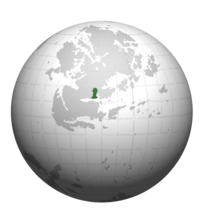Bergenaria
Bergenaria Reino Federal de Bergenaria | |
|---|---|
| 'Motto: 'Equidad en la Justicia Equality in Justice | |
| Anthem: "¡Oíd, mortales!, el grito sagrado!" | |
 | |
| Capital | Serenno |
| Official languages | Stillian de facto |
| Recognized languages | Stillian and 12 Aromatic languages |
| Ethnic groups | Bergenaran, Anirians, and other diverse groups. |
| Religion |
|
| Demonym(s) | Bergenaro, Bergenario. |
| Government | Federal parliamentary constitutional monarchy |
| Clemente VIII | |
| Sonia Almenares | |
| Legislature | Congreso Nacional |
| Senate | |
| Chamber of Deputies | |
| Unification | |
• Collapse of the Holy Bergenaran Empire | 12 September 1834 |
• Consumation of the Revolución Liberal | 18 September 1834 |
• Start of the Revolución del Cempasuchil | 2 November 1867 |
• Proclamation of the Kingdom | 1 January 1873 |
• Two Thousand Days War | 21 November 1948 |
• Current constitution | 29 December 1971 |
| Area | |
• Total | 238,900 km2 (92,200 sq mi) |
| Population | |
• 2020 census | 29,000,000 |
• Density | 121.3/km2 (314.2/sq mi) |
| GDP (PPP) | 2020 estimate |
• Total | $439,350 million |
| GDP (nominal) | 2020 estimate |
• Per capita | $15,150 |
| Gini (2016) | 33.0 medium |
| HDI (2019) | 0.904 very high |
| Currency | Bergenarian real (BGR) ([[Wikipedia:ISO 4217|ISO 4217]]) |
| Time zone | UTC+6 UTC +7 |
| Date format | dd-mm-yyyy |
| Driving side | right |
| Calling code | +34 |
| Internet TLD | .ber |
Bergenaria, officially known as the Federal Kingdom of Bergenaria (Stillian: Reino Federal de Bergenaria) is a country located in the central Amutian part of Europa on Eurth. It is bordered to the east by Red Iberos, to the north by Qubdi and to the south by Haken Bay and Norrium. Bergenaria covers 238,900 square kilometres (92,200 sq mi), and is home to approximately 29 million people. The capital and largest city of Bergenaria is Serenno. Other major urban areas include Santiago de Ángeles, Caronia, Izquina, Arianza, San Cristóbal de Grenica, Zamora, Santa Catarina de Compostela, and Aniria, all around eighteen autonomous communities.
Anatomically modern humans lived in the temperate caves of the country from around 17,000 BCE. Modern archaeologists and anthropologists maintain that the settlement known as the Arianza Complex (Stillian: Complejo de Arianza) could have been the first city founded when human beings moved to a sedentary lifestyle and agriculture. Different societies were formed around the current Cempasúchil Valley (Stillian: Valle de Cempasúchil) with city-states such as Caronia, Arianza and Zamora having the hegemony of trade in the area. The expansion of the Aroman Empire eventually reached and brought to a halt the expansion of said city-states, albeit bringing an Aroman acculturation of the population. Aniria remained under Aromatic control until presumably around the 3rd century CE. Around the 9th century CE, the region became a caliphate after Norric conquests. Catholic kingdoms emerged on the northwest of the valley, notably Aniria, a resurgent Caronia, Lisoria and Valparia and over the next six centuries, an intermittent southward expansion of these kingdoms, known as Reconquista, culminated with the Cathloic seizure of the Emirate of Samarat in 1385. With the end of the Reconquista, under the treaty of Grenica, the Catholic kingdoms divided their lands based upon their gains in the front. The treaty also gave rise to the called Holy Bergenaran Empire. Centralisation of the administration and further State-building in the valley ensued in the 18th and 19th centuries, during which the Crown saw the called Revolución Liberal. The country veered between different political regimes; monarchy and republic, with the first prevailing after a 1948-54 civil war. With the aperture of the kingdom and transition to democracy under the Bergenarian Constitution of 1993, the country experienced profound social and political change as well as an important economic growth.
Bergenaria is often considered a developed country, with a secular parliamentary democracy and a constitutional monarchy, with King Clemente VII as head of state. It is a high-income country and an advanced economy, but a relatively low population that is still recovering from the last times of troubles. Bergenaria has one of the longest life expectancies in Europa at 79.9 years in 2019. It ranks particularly high in healthcare quality, with its healthcare system considered to be one of the most efficient worldwide.
Etymology
There are several hypotheses about the origin of the word Bergenaria. The first version suggests that it comes from a mispronunciation by Catholic generals of the Berengaria River that crossed the current capital of Serenno during the Reconquista. The second and the most accepted theory suggests that Bergenaria comes from Queen Bergenaria of Caronia, wife of King Damaso de Aniria which united briefly the kingdoms into an alliance. Legend says that during the height of the Reconquista, Bergenaria rode on a horse with a spear and a shield during the Siege of Arianza. When victorious, she took hands with her husband, creating the image of the coat of arms.

